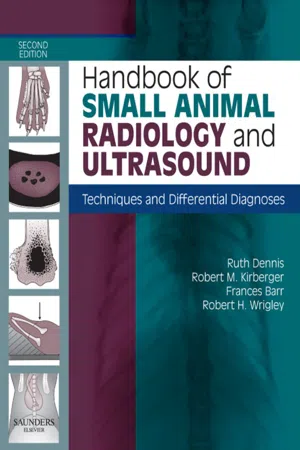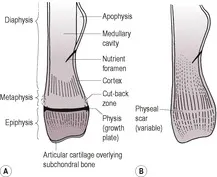
Handbook of Small Animal Radiological Differential Diagnosis E-Book
Handbook of Small Animal Radiological Differential Diagnosis E-Book
- 382 pages
- English
- ePUB (mobile friendly)
- Available on iOS & Android
Handbook of Small Animal Radiological Differential Diagnosis E-Book
Handbook of Small Animal Radiological Differential Diagnosis E-Book
About this book
The Handbook of Small Animal Radiology and Ultrasound: Techniques and Differential Diagnoses provides a user-friendly reference for a wide range of radiographic and ultrasonographic findings in dogs and cats.Key features- Enables successful and clear interpretation of radiographs and ultrasonograms- Offers clearly sequenced text arrangement from the identification of the radiographic or sonographic abnormalities to a list of subsequent considerations for each sign- Prioritizes different clinical findings to tailor further diagnostic tests or therapeutic interventions- Takes imaging abnormalities from the descriptive to the interpretative New to this edition- Colour throughout enhances user-friendliness- Many new conditions- Extra illustrations show techniques and normal anatomy- Additional information on techniques, normal appearance and disease processes- Expanded Further Reading sections This book is intended for all users of small animal diagnostic imaging, from radiologists through to general practitioners to veterinary students, and will be an invaluable supplement to existing references in the subject.
Frequently asked questions
- Essential is ideal for learners and professionals who enjoy exploring a wide range of subjects. Access the Essential Library with 800,000+ trusted titles and best-sellers across business, personal growth, and the humanities. Includes unlimited reading time and Standard Read Aloud voice.
- Complete: Perfect for advanced learners and researchers needing full, unrestricted access. Unlock 1.4M+ books across hundreds of subjects, including academic and specialized titles. The Complete Plan also includes advanced features like Premium Read Aloud and Research Assistant.
Please note we cannot support devices running on iOS 13 and Android 7 or earlier. Learn more about using the app.
Information
general
CHAPTER CONTENTS
GENERAL
1.1. RADIOGRAPHIC TECHNIQUE FOR THE SKELETAL SYSTEM
1.2. ANATOMY OF BONE: GENERAL PRINCIPLES (Fig. 1.1A and B)
 |
| Figure 1.1 (A) Anatomical features of an immature long bone; (B) anatomical features of a mature long bone. |
Table of contents
- Cover Image
- Table of Contents
- Front matter
- Copyright
- Foreword
- Preface
- Acknowledgements
- Chapter 1. Skeletal system
- Chapter 2. Joints
- Chapter 3. Appendicular skeleton
- Chapter 4. Head and neck
- Chapter 5. Spine
- Chapter 6. Lower respiratory tract
- Chapter 7. Cardiovascular system
- Chapter 8. Other thoracic structures
- Chapter 9. Other abdominal structures
- Chapter 10. Gastrointestinal tract
- Chapter 11. Urogenital tract
- Chapter 12. Soft tissues
- Appendix
- Index